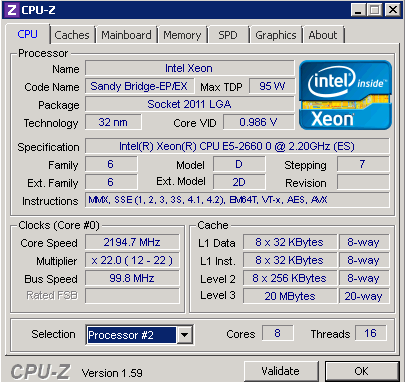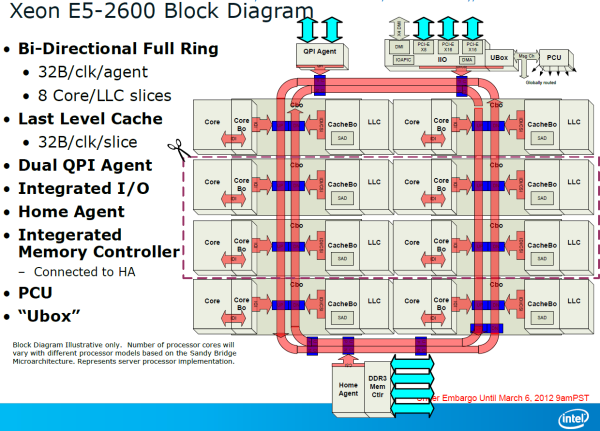The Xeon E5-2600: Dual Sandy Bridge for Servers
by Johan De Gelas on March 6, 2012 9:27 AM EST- Posted in
- IT Computing
- Virtualization
- Xeon
- Opteron
- Cloud Computing
Intel's Sandy Bridge architecture was introduced to desktop users more than a year ago. Server parts however have been much slower to arrive, as it has taken Intel that long to transpose this new engine into a Xeon processor. Although the core architecture is the same, the system architecture is significantly different from the LGA-1155 CPUs, making this CPU quite a challenge, even for Intel. Completing their work late last year, Intel first introduced the resulting design as the six-core high-end Sandy Bridge-E desktop CPU, and since then have been preparing SNB-E for use in Xeon processors. This has taken a few more months but Xeon users' waits are at an end at last, as today Intel is launching their first SNB-E based Xeons .
Compared to its predecessor, the Xeon X5600, the Xeon E5-2600 offers a number of improvements:
A completely improved core, as described here in Anand's article. For example, the µop cache lowers the pressure on the decoding stages and lowers power consumption, killing two birds with one stone. Other core improvements include an improved branch prediction unit and a more efficient Out-of-Order backend with larger buffers.
A vastly improved Turbo 2.0. The CPU can briefly go beyond the TDP limits, and when returning to the TDP limit, the CPU can sustain higher "steady-state" clockspeed. According to Intel, enabling turbo allows the Xeon E5 to perform 14% better in the SAP S&D 2 tier test. This compares well with the Turbo inside the Xeon 5600 which could only boost performance by 4% in the SAP benchmark.
Support for AVX Instructions combined with doubling the load bandwidth should allow the Xeon to double the peak floating point performance compared to the Xeon "Westmere" 5600.
A bi-directional 32 byte ring interconnect that connects the 8 cores, the L3-cache, the QPI agent and the integrated memory controller. The ring replaces the individual wires from each core to the L3-cache. One of the advantages is that the wiring to the L3-cache can be simplified and it is easier to make the bandwidth scale with the number of cores. The disadvantage is that the latency is variable: it depends on how many hops a certain piece of data inside the L3-cache must cross before ends up at the right core.
A faster QPI: revision 1.1, which delivers up to 8 GT/s instead of 6.4 GT/s (Westmere).
Lower latency to PCI-e devices. Intel integrated a PCIe 3.0 I/O subsystem inside the die which sits on the same bi-directional 32 bit ring as the cores. PCIe 3.0 runs at 8 GT/s (PCIe 2.0: 5 GT/s), but the encoding has less overhead. As a result, PCIe 3.0 can deliver up to 1 GB full duplex per second per lane, which is twice as much as PCIe 2.0.
Removing the I/O lowered PCIe latency by 25% on average according to Intel. If you only access the local memory, Intel measured 32% lower read latency.
The access latency to PCIe I/O devices is not only significantly lower, but Intel's Data Direct I/O Technology allows the PCIe NICs to read and write directly to the L3-cache instead of to the main memory. In extremely bandwidth constrained situations (using 4 infiniband controllers or similar), this lowers power consumption and reduces latency by another 18%, which is a boon to HPC users with 10G Ethernet or Infiniband NICs.
The new Xeon also supports faster DDR-3 1600, up to 2 DIMMs per channel can run at 1600 MHz.

Last but certainly not least: 2 additional cores and up to 66% more L3 cache (20 MB instead of 12 MB). Even with 8 cores and a PCIe agent (40 lanes), the Xeon E5 still runs at 2.2 GHz within a 95W TDP power envelope. Pretty impressive when compared with both the Opteron 6200 and Xeon 5600.











81 Comments
View All Comments
JohanAnandtech - Wednesday, March 7, 2012 - link
Argh. You are absolutely right. I reversed all divisions. I am fixing this as we type. Luckily this does not alter the conclusion: LS-DYNA does not scale with clockspeed very well.alpha754293 - Wednesday, March 7, 2012 - link
I think that I might have an answer for you as to why it might not scale well with clock speed.When you start a multiprocessor LS-DYNA run, it goes through a stage where it decomposes the problem (through a process called recursive coordinate bisection (RCB)).
This decomposition phase is done every time you start the run, and it only runs on a single processor/core. So, suppose that you have a dual-socket server where the processors say...are hitting 4 GHz. That can potentially be faster than say if you had a four-socket server, but each of the processors are only 2.4 GHz.
In the first case, you have a small number of really fast cores (and so it will decompose the domain very quickly), whereas in the latter, you have a large number of much slower cores, so the decomposition will happen slowly, but it MIGHT be able to solve the rest of it slightly faster (to make up for the difference) just because you're throwing more hardware at it.
Here's where you can do a little more experimenting if you like.
Using the pfile (command line option/flag 'p=file'), not only can you control the decomposition method, but you can also tell it to write the decomposition to a file.
So had you had more time, what I would have probably done is written out the decompositions for all of the various permutations you're going to be running. (n-cores, m-number of files.)
When you start the run, instead of it having to decompose the problem over and over again each time it starts, you just use the decomposition that it's already done (once) and then that way, you would only be testing PURELY the solving part of the run, rather than from beginning to end. (That isn't to say that the results you've got is bad - it's good data), but that should help to take more variables out of the equation when it comes to why it doesn't scale well with clock speed. (It should).
IntelUser2000 - Tuesday, March 6, 2012 - link
Please refrain from creating flamebait in your posts. Your post is almost like spam, almost no useful information is there. If you are going to love one side, don't hate the other.Alexko - Tuesday, March 6, 2012 - link
It's not "like spam", it's just plain spam at this point. A little ban + mass delete combo seems to be in order, just to cleanup this thread—and probably others.ultimav - Wednesday, March 7, 2012 - link
My troll meter is reading off the charts with this guy. Reading between the lines, he's actually a hardcore AMD fan trying to come across as the Intel version of Sharikou to paint Intel fans in a bad light. Pretty obvious actually.JohanAnandtech - Wednesday, March 7, 2012 - link
We had to mass delete his posts as they indeed did not contain any useful info and were full of insults. The signal to noise ratio has been good the last years, so we must keep it that way.Inteluser2000, Alexko, Ultimav, tipoo: thx for helping to keep the tone civil here. Appreciate it.
- Johan.
tipoo - Wednesday, March 7, 2012 - link
And thank you for removing that stuff.tipoo - Tuesday, March 6, 2012 - link
We get it. Don't spam the whole place with the same post.tipoo - Tuesday, March 6, 2012 - link
No, he's just a rational persons. I don't care which company you like, if you say the same thing 10 times in one article someones sure to get annoyed and with justification.MySchizoBuddy - Tuesday, March 6, 2012 - link
I'm again requesting that when you do the benchmarks please do a Performance per watt metric along with stress testing by running folding@home for straight 48hours.